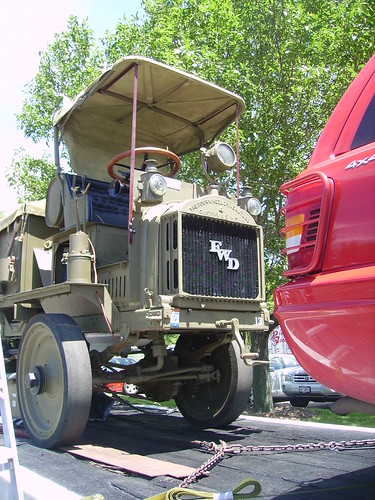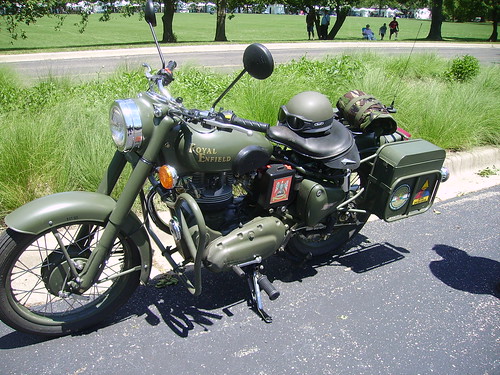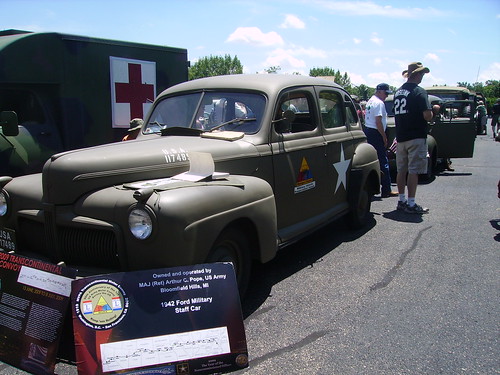
Hi all! I promised a genealogy entry and I found the perfect topic.
To celebrate the 90th anniversary of the Transcontinental Motor Convoy, a reenactment took place. One of the stops on the tour was practically on my doorstop, at the First Division Museum at Cantigny Park.
Different from the first and second tour, the convoy had vehicles from many wars, all the way up to Desert Storm.

What's that? You never heard of the first Transcontinental Motor Convoy from 1919 or the second in 1920?
Do you have any idea what they accomplished? Well, I didn't either. So I had grabbed a knowledgeable comrade (who's intending to get a Masters in military history), and started some research.

A photo from the original convoy. Source: http://arcweb.archives.gov/arc/arch_results_detail.jsp?&pg=27&si=0&st=b&rp=digital&nh=27
The first one was done to raise awareness of the state of the Lincoln Highway. The road was in such horrendous shape that they found bridges collapsing under the weight of the 81 military vehicles, and they barely got 60 miles per day!

At each stop, the convoy was greeted with barbecues, dances and very well received.
Most people agree the first convoy was a success in that they got a world record for the longest distance traveled by a motor convoy, public support for the military and repairing roads was higher than when they left.
The second convoy, done in 1920, was done to raise public support for a national highway system. It was a bit smaller, about 50 vehicles, and found issues with the Mississippi flooding, and impassable desert sands in the Southwest.

Its debated the effect the second one had - while the crew was again greeted with parties and press, they failed to garner support for a national highway bill (though a bill passed in 1921).
Longterm, these convoys did have an effect on the future of America. President Eisenhower, a rider on the first convoy, supported the Federal Aid Highway Act of 1956 (which created many of the highways we know and love today), partly because of his experiences with the first ride and even told some stories about it in his book, At Ease: Stories I Tell to Friends (Doubleday and Company, Inc., 1967).

This new convoy, as we were told, has more than a single purpose -
1. To celebrate the anniversary of the 1st convoy
2. To celebrate the 200th anniversary of President Lincoln
3. To celebrate the fine work of the US military.
In all, I think that it succeeded. They visited Cantigny on the same weekend as the Fine Art Fair, and seemed to have quite a few visitors. Many were little kids who hadn't seen anything like that before.

Anyway, getting back to the genealogy of the convoy...
1. Learn more about it. NARA has a section on their website under "America on the Move".
2. Search the newspapers for the local community. ALL of them would have covered this, as it was a big deal when the convoy came to town.
For example, the Fort Wayne Gazette from Fort Wayne, Indiana on July 19, 1919 discussed the aspect of H. S. Firestone donating vehicles, and the Reno Evening Gazette from Reno, Nevada on September 6, 1919 discussed statements by Lieutenant Colonel C.W. McClure, the leader of the convoy, and the efforts of Captain J.H. Murphy, who was in charge of recruiting.
An article from the conclusion of the trip on September 7, 1919 in the Oakland Tribune, gives a list of official observers from the trip. You never know what you might find!
I suggest if you try Ancestry.com, to search 1919 for keywords "Transcontinental Motor Convoy" and see what happens.
3. The Eisenhower Library has quite a few records about his time in the convoy.
4. Check out more about the new convoy at the MVPA website.
This video was taken by the MVPA as the convoy was going through Iowa.
Sources:
Ancestry.com - Copies of the Reno Evening Gazette, Oakland Tribune, and Fort Wayne Gazette.
MVPA.org
AmericasLibrary.gov
Eisenhower.archives.gov
History.sandiego.edu


No comments:
Post a Comment